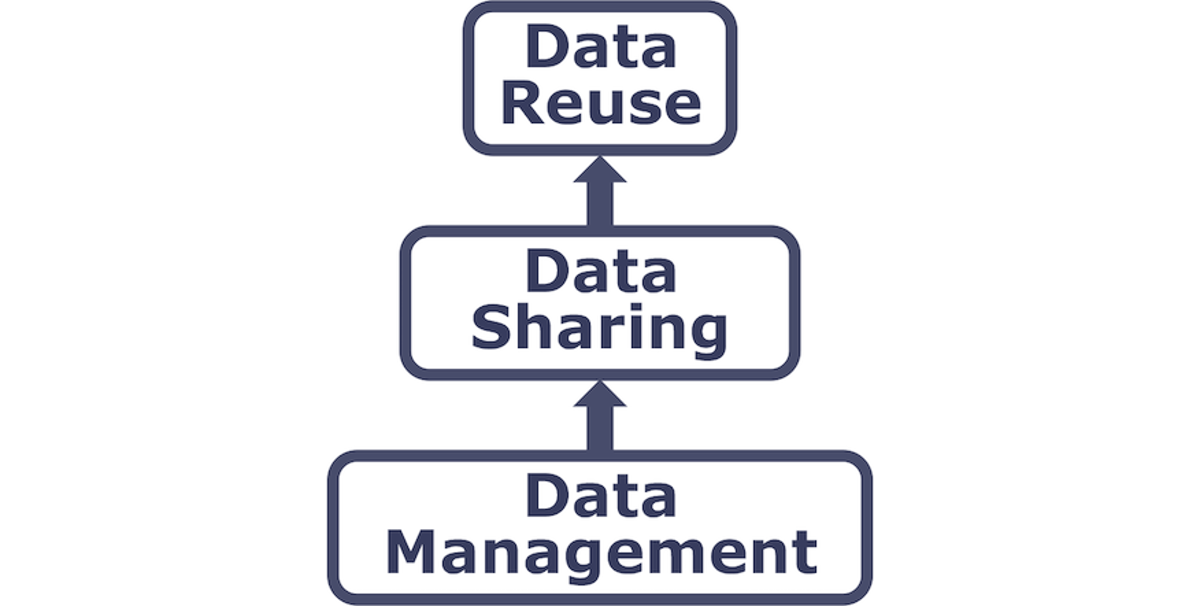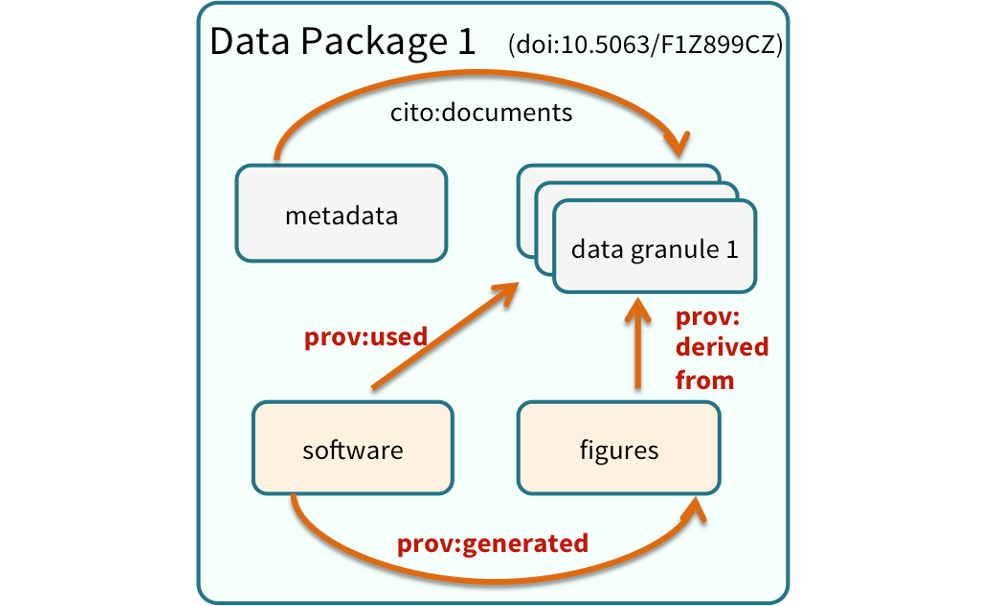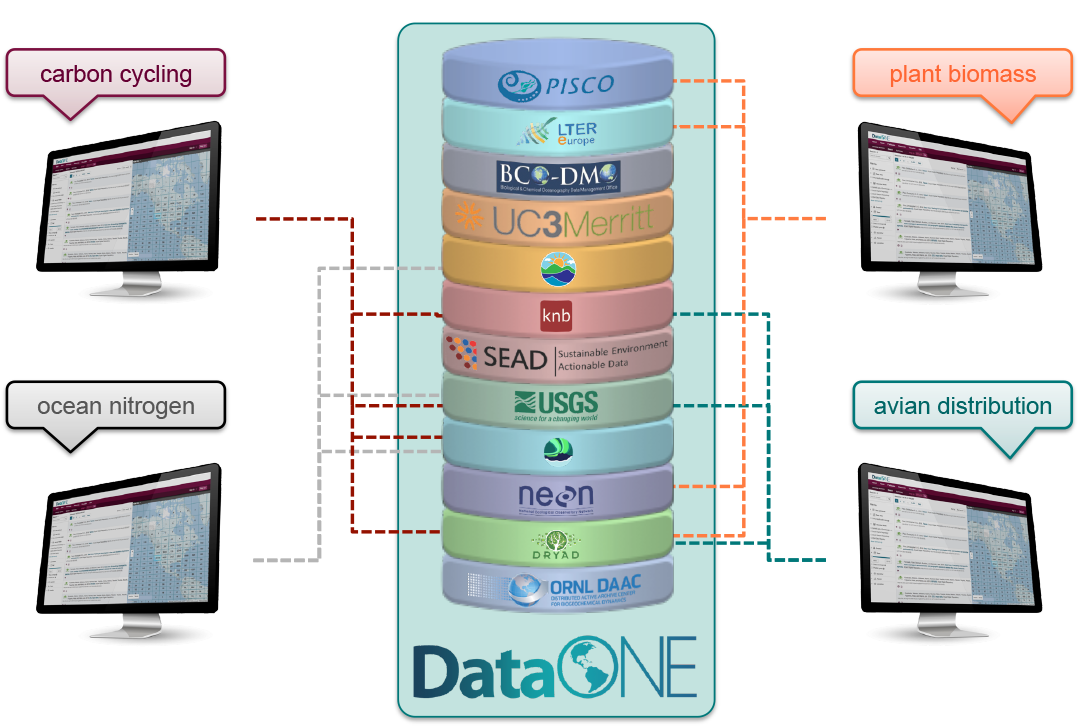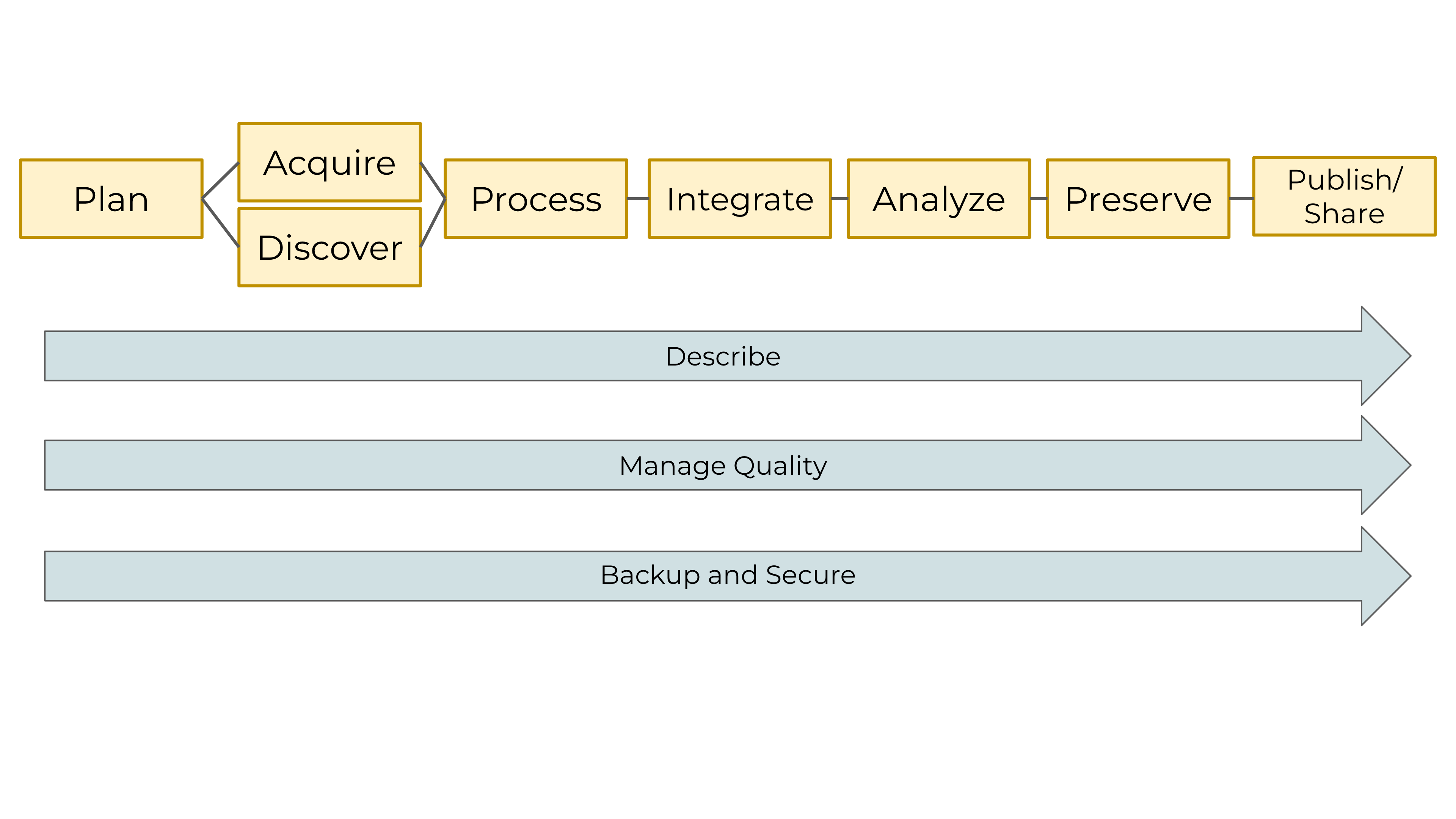Learning Objectives
- Understand the importance of data management for successfully preserving data
- Review the Data Life Cycle and how it can guide the data management in a project
- Familiarize with data management plans and start thinking about one for your project
- Learn about metadata guidelines and best practices for reproducibility
- Become familiar with environmental data repositories for accessing and publishing data
The Big Idea
This lesson aims to get you thinking about how are you going to manage your data. Even though you are in the early stages of defining you research project, we believe that when it comes to data management, the earlier you start thinking about it the better.
Introduction
Data management is the process of handling, organizing, documenting, and preserving data used in a research project. This is particularly important in synthesis science given the nature of synthesis, which involves combining data and information from multiple sources to answer broader questions, generate knowledge and provide insights into a particular problem or phenomenon.
Benefits of managing your data
Successfully managing your data throughout a research project helps ensures its preservation for future use. It also facilitates collaboration within your team, and it helps advance your scientific outcomes.
From a researcher perspective
- Keep yourself organized – be able to find your files (data inputs, analytic scripts, outputs at various stages of the analytic process, etc.)
- Track your science processes for reproducibility – be able to match up your outputs with exact inputs and transformations that produced them
- Better control versions of data – easily identify versions that can be periodically purged
- Quality control your data more efficiently
- To avoid data loss (e.g. making backups)
- Format your data for re-use (by yourself or others)
- Be prepared to document your data for your own recollection, accountability, and re-use (by yourself or others)
- Gain credibility and recognition for your science efforts through data sharing!
Advancement of science
- Data is a valuable asset – it is expensive and time consuming to collect
- Maximize the effective use and value of data and information assets
- Continually improve the quality including: data accuracy, integrity, integration, timeliness of data capture and presentation, relevance, and usefulness
- Ensure appropriate use of data and information
- Facilitate data sharing
- Ensure sustainability and accessibility in long term for re-use in science
The Data Life Cycle
The Data Life Cycle gives you an overview of meaningful steps data goes through in a research project, from planning to archival. This step-by-step breakdown facilitates overseeing individual actions, operations and processes required at each stage. This is a visual tool that aims o help scientists plan and anticipate what will be the “data needs” for a specific project (Faundeen et al 2013) .
Primary Elements
| Plan |
Map out the processes and resources for all activities related to the handling of the project’s data assets. Start with the project goals (desired outputs, outcomes, and impacts) and work backwards to build a data management plan, supporting data policies, and sustainability plans for each step. |
Data Management Plan (DPM) |
| Acquire & Discover |
Activities needed to collect new or existing data. You can structure the process of collecting data upfront to better implement data management. Consider data policies and best practices that maintain the provenance and integrity of the data. |
Identifying data sources and mechanisms to access data |
| Process |
Every step needed to prepare new or existing data to be able to use it as an input for synthesis. Consider the structure of the data, unit transformation, extrapolations, etc |
Cleaning & Wrangling data skills |
| Integrate |
Data from multiple sources are combined into a form that can be readily analyzed. Successful data integration depends on documentation of the integration process, clearly citing and making accessible the data you are using, and employing good data management practices throughout the Data Life Cycle. |
Modeling & Interpretation |
| Analyze |
Create analyses and visualizations to identify patterns, test hypotheses, and illustrate findings. During this process, record your methods, document data processing steps, and ensure your data are reproducible. Learn about these best practices and more. |
Modeling, Interpretation & Statistics |
| Preserve |
Plan on how you are going to store your data for long-term use and accessibility so others can access, interpret, and use the data in the future. Decide what data to preserve, where to preserve it, and what documentation needs to accompany the data. |
Data packages & repositories |
| Publish and Share |
Publication and distribution of your data through the web or in data catalogs, social media or other venues to increase the chances of your data being discovered. Data is a research product as publications are. |
DOIs and citations |
Cross-Cutting Elements
These elements are involved across all stages describes above. They need to constantly by addressed throughout all the Data Life Cycle, making sure effective data management is in place.
| Describe |
Document data and each of the data stages by describing the why, who, what, when, where, and how of the data and processes. Metadata, or data about data, is key to data sharing and reuse. Documentation such as software code comments, data models, and workflows facilitate indexing, acquiring, understanding, and future uses of the data |
Metadata and documentation |
| Manage Quality |
Employ quality assurance and quality control procedures that enhance the quality of data, making sure the measurements or outputs within expected values.Identify potential errors and techniques to address them. |
Quality Control and Quality Assurance techniques |
| Backup and Secure |
Plan to preserve data in the short term to minimize potential losses (e.g., via software failure, human error, natural disaster). This avoids risk and ensures data is accessible to collaborators. This applies to raw and process data, original science plan, data management plan, data acquisition strategy, processing procedures, versioning, analysis methods, published products, and associated metadata |
Servers, secure data sharing services |
Data Management Plans
As you can see there is a lot happening around the Data Life Cycle. This is why PLANNING is a key first step. It is advisable to initiate your data management planning at the beginning of your research process before any data has been collected or discovered.
In order to better plan and keep track of all the moving pieces when working with data, a good place to start is creating a Data Management Plan. However, this is not only the starting point. This is a “living” document that should be consulted and updated throughout the project.
A Data Management Plan (DMP) is a document that describes how you will use your data during a research project, as well as what you will do with your data long after the project ends. DMPs should be updated as research plans change to ensure new data management practices are captured (Environmental Data Initiative).
A well-thought-out plan means you are more likely to:
- stay organized
- work efficiently
- truly share data
- engage your team
- meet funder requirements as DMPs are becoming common in the submission process for proposals
A DMP is both a straightforward blueprint for how you manage your data, and provides guidelines for you and your team on policies, roles and responsibilities. While it is important to plan, it is equally important to recognize that no plan is perfect, as change is inevitable. To make your DMP as robust as possible, review it periodically with your team and adjust as the needs of the project change.
- Plan early - information gets lost over time. Think about your data needs as you are starting your project.
- Plan in collaboration - engaging all the team makes your plan more resilient, including diverse expertise and perspectives.
- Make revision part of the process - adapt as needed, revising your plan helps you make sure your are on track.
- Include a tidy data and data ethic lens
Creating a Good Data management Plan
The article Ten Simple Rules for Creating a Good Data Management Plan (Michener (2015)) outlines big picture ideas to keep in mind when you start your “planning stage”. Here we summarize each point and provide useful resources or examples to help you achieve this “rules” and write an awesome DMP.
Identify the desired/necessary data sets for the project
Define how the data will be organized
Explain how the data will be documented
Describe how data quality will be assured
Quality assurance and quality control (QA/QC) are the procedures taken to ensure data looks how we expect it to be. The ultimate goal is to improve the quality of the data products. Some fields of study, data types or funding organizations have specific set of guidelines for QA/QCing data. However, when writing your DMP it is important to describe what measures you plan to take to QA/QC the data (e.g: instrument calibration, verification tests, visualization approaches for error detection, etc.)
Resources
Have a data storage strategy (short and long term)
Papers get lost, hardware disk crash, URLs break, different media format degrade. It’s inevitable! Plan ahead and think on where your data will live in the short and long-term to ensure the access and use of this data during and long after the project. It is important to have a backup mechanism in place during the project to avoid losing any information.
Resource
- Remote locations to store your data during your project are: institutional repositories or servers or commercial services such as Amazon, Dropbox, Google, Microsoft, Box, etc.
- Long-term storage: identify an appropriate and stable data repository for your research domain (See section 3.6 Data Preservation and Sharing)
Define the project’s data policies
Many organizations and institutions require to include an explicit policy statement about how data will be managed and shared. Including licensing or sharing arrangements and legal and ethical restrictions on access and use of human subject and other sensitive data. It is valuable to establish a shared agreement around handling of data when embarking on collaborative projects. Collaborative research brings together data from across research projects with different data management plans and can include publicly accessible data from repositories where no management plan is available. For these reasons, a discussion and agreement around the handling of data brought into and resulting from the collaboration is warranted, and management of this new data may benefit from going through a data management planning process.
Resource
- Template provided by the Arctic Data Center, including sections for individual data not in the public domain, individual data with public access, derived data resulting from the project.
What data products will be made available and how?
This portion of the DMP tries to ensure that the data products of your project will be disseminated. This can be achieved by stating how, when and where these products will be available. We encourage open data practices, this means making data extensively available and with the least restrictions possible.
Examples
- Publishing the data in an open repository or archive
- Submitting the data (or subsets thereof) as appendices or supplements to journal articles
- Publishing the data, metadata, and relevant code as a “data paper”
Assign roles and responsibilities
- It is important to clearly determine the roles and responsibilities of each group member of the project. Roles may include data collection, data entry, QA/QC, metadata creation and management, backup, data preparation and submission to an archive, and systems administration.
Prepare a realistic budget
- Generally overlooked, but preparing a realistic budget it’s an important part when planning for your data management. Data management takes time and it may have cost associates to it for example access to software, hardware, and personnel. Make sure you plan considers budget to support people involved as well as software or data fees or other services as needed.
Data Preservation & Sharing

Data Packages
We define a data package as a scientifically useful collection of data and metadata that a researcher wants to preserve.
Sometimes a data package represents all of the data from a particular experiment, while at other times it might be all of the data from a grant, or on a topic, or associated with a paper. Whatever the extent, we define a data package as having one or more data files, software files, and other scientific products such as graphs and images, all tied together with a descriptive metadata document.
Many data repositories assign a unique identifier to every version of every data file, similarly to how it works with source code commits in GitHub. Those identifiers usually take one of two forms. A DOI identifier, often assigned to the metadata and becomes a publicly citable identifier for the package. Each of the other files gets a global identifier, often a UUID that is globally unique. This allows to identify a digital entity within a data package.
In the graphic to the side, the package can be cited with the DOI doi:10.5063/F1Z1899CZ,and each of the individual files have their own identifiers as well.

Data Repositories: Built for Data (and code)
- GitHub is not an archival location
- Examples of dedicated data repositories:
- KNB
- Arctic Data Center
- tDAR
- EDI
- Zenodo
- Dedicated data repositories are:
- Rich in metadata
- Archival in their mission
- Certified
- Data papers, e.g., Scientific Data
- re3data is a global registry of research data repositories
- Repository Finder is a pilot project and tool to help researchers find an appropriate repository for their work
DataOne Federation
DataONE is a federation of dozens of data repositories that work together to make their systems interoperable and to provide a single unified search system that spans the repositories. DataONE aims to make it simpler for researchers to publish data to one of its member repositories, and then to discover and download that data for reuse in synthetic analyses.
DataONE can be searched on the web, which effectively allows a single search to find data from the dozens of members of DataONE, rather than visiting each of the (currently 44!) repositories one at a time.

Summary
- The Data Life Cycle help us see the big picture of our data project.
- It is extremely helpful to develop a data management plan describing each step of the data life cycle to stay organized.
- Document everything. Having rich metadata is a key factor to enable data reuse. Describe your data and files and use an appropriate metadata standard.
- Identify software and tools that will help you and your team organize and document the project’s data life cycle.
- Publish your data in a stable long live repository and assign a unique identifier.
Activity
Using the Logic Models you started on Monday, read the questions in this document. Answer as many as possible to the best of your knowledge. Identify which aspects of managing your data are easier to think about and which ones are more difficult, or you need more guidance.



